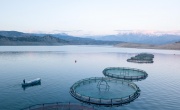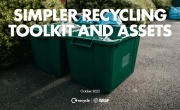PET-eating bacteria found by researchers
 Researchers in Japan have found a species of bacteria that can break down polyethylene terephthalate (PET), which is used extensively in plastic products, into ‘basic building blocks’ for creating new plastic products.
Researchers in Japan have found a species of bacteria that can break down polyethylene terephthalate (PET), which is used extensively in plastic products, into ‘basic building blocks’ for creating new plastic products.
‘A bacterium that degrades and assimilates poly(ethylene terephthalate)’ was published in the journal Science last week, with the writers claiming that the novel bacterium (Ideonella sakaiensis 201-F6) is able to use PET as its main energy and carbon source.
The researchers found that, when grown on PET, the new species produces two enzymes capable of hydrolysing the material as well as the primary reaction intermediate (mono(2-hydroxyethyl) terephthalic acid), eventually yielding ‘basic building blocks for growth’.
The team of researchers from Kyoto Institute of Technology and Keio University collected 250 samples of natural microbial communities exposed to PET in the environment near a plastic bottle recycling facility (in sediment, soil and wastewater), and found that this one bacteria is able to use PET as its major energy and carbon source.
However, it remains to be seen how viable the bacteria would be as a solution for biodegrading plastics, as the team determined that it takes six weeks to break down a thin film of PET, and only if the temperature is kept at an even 30 degrees Celsius.
However, with the research in its early stages, the research team is calling for patience. Professor Kenji Miyamoto from Keio University, one of the authors of the study, said: “It’s difficult to break down highly crystallised PET [used in plastic bottles]. Our research results are just the initiation for the application. We have to work on so many issues needed for various applications. It takes a long time.”
Process no ‘better than putting plastic bottles in a recycling bin’
According to the ‘New Plastics Economy’ report released in January by the Ellen MacArthur Foundation and World Economic Forum (WEF), PET makes up almost a sixth of the world’s annual plastic production of 311 million tonnes, although only just over half is ever collected for recycling.
The news that it could potentially be broken down by bacteria has been met with a mixed response from the scientific community, with some claiming that plastic could be less toxic in its whole, unhydrolysed form, and others pointing out that a biodegradation system would require setting up a complicated, economically unviable engineering process on a scale similar to chemical recycling.
Commenting on the new Japanese research, Dr Tracy Mincer, a researcher at the Woods Hole Oceanographic Institution in Massachusetts, said: “I don’t see how microbes degrading plastics is any better than putting plastic bottles in a recycling bin so they can be melted down to make new ones.”
However, Mincer said the research could make it easier to identify other microbes that may have similar PET-degrading capabilities: “This process could be quite common. Now that we know what we are looking for, we may see these microbes in many areas around the world.”
A biological agent in nature
With concerns growing over the amount of plastic waste polluting our oceans, and the prediction that there could be one tonne of plastic for every three tonnes of fish by 2025 (according to The Ocean Conservancy), researchers are increasingly focusing on the problem of plastic in the oceans.
Professor of microbiology at Swinburne University Enzo Palombo suggests that a potential application of this discovery is as a biological agent in nature. Speaking to the Guardian, Palombo said that this particular bacterium would not be suitable for this purpose, but he “would not be surprised if samples of ocean plastics contained microbes that are happily growing on this material and could be isolated in the same manner”.
On the other hand, Mincer said that breaking down ocean rubbish came with dangers of its own. WEF estimates that the 150 million tonnes of plastic currently in the ocean contains roughly 23 million tonnes of additives, which could be toxic if released.
The full paper can be read at the journal Science website.







